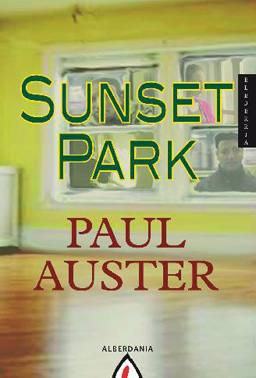
The worst years of our lives?
- Paul Auster ::Sunset Park Location of Alberdania Pages in category:272 The price: 19.50€
Saioa Ruiz Gonzalez
2011ko urriaren 05

Sunset park
Through his novel The Madness of Brooklyn (Brooklyn Follies, 2006), he anticipated the first brushstrokes of a way of life that would end with the events of September 2001. Along with a certain “happy” ending to the novel, this vague image, which gave the beginning of a project left open, has become a true picture of the post-I-11 world in Sunset Park. It is not a mere descriptive analysis of society but what Auster does, always centered on the human being, starting from what his characters have endured and lived, offers an updated portrait of the socio-political situation in the United States. Obama’s newly elected presidency, the length of the war in Iraq and the desperation between couples that causes it, the 2008 economic blockade, the suffering of thousands of families forced to live on the street by unpayable loans and rents. Since In the Country of the Last Things (1987), I don’t remember any work in Auster’s literary career that reflects the social consequences of the cruelest violent capitalism. And this time again, the characters’ attempts to survive on a day-to-day basis are dominated by a pessimistic panorama of the contemporary world that does not offer a hopeful future.
Sunset Park is much more than just one of New York’s poor neighborhoods; a micro world embedded in this “Crazy and Destructive Monster” (page 153). In an abandoned local house, the occupation is the burrow of the ruined lives of the four young people who live. Driven to flee by a past incident, they are wounded creatures who have just returned to their homeland. Without the superimposed narratives that are typical of the writer, section by section, well differentiated, the past of each character is expanding. This is how the typical constellation network of the Austerian universe that is so familiar to us is embodied: The atmosphere in Brooklyn, the tragedies within the family, the constant presence of unexpected death that evokes the weakness of the human being, the burden of guilt, the corrupt relationships of love and, of course, the extraordinarily rich intertextuality (baseball, cinema, literature). In a world that is upside down, in a reality devoid of combat incentives, it is ruled by the obsessive presence of Wiliam Wyler’s The Best Years of Our Lives (1946). Like soldiers stemming from a war of the past, it seems to me a rather exaggerated pessimistic portrait of a group of young people who cannot believe in the future.
No one said life was easy, but to add another topic, hope is the last thing that is lost. And as long as literature exists, this topic survives.
Sunset Park is much more than just one of New York’s poor neighborhoods; a micro world embedded in this “Crazy and Destructive Monster” (page 153). In an abandoned local house, the occupation is the burrow of the ruined lives of the four young people who live. Driven to flee by a past incident, they are wounded creatures who have just returned to their homeland. Without the superimposed narratives that are typical of the writer, section by section, well differentiated, the past of each character is expanding. This is how the typical constellation network of the Austerian universe that is so familiar to us is embodied: The atmosphere in Brooklyn, the tragedies within the family, the constant presence of unexpected death that evokes the weakness of the human being, the burden of guilt, the corrupt relationships of love and, of course, the extraordinarily rich intertextuality (baseball, cinema, literature). In a world that is upside down, in a reality devoid of combat incentives, it is ruled by the obsessive presence of Wiliam Wyler’s The Best Years of Our Lives (1946). Like soldiers stemming from a war of the past, it seems to me a rather exaggerated pessimistic portrait of a group of young people who cannot believe in the future.
No one said life was easy, but to add another topic, hope is the last thing that is lost. And as long as literature exists, this topic survives.